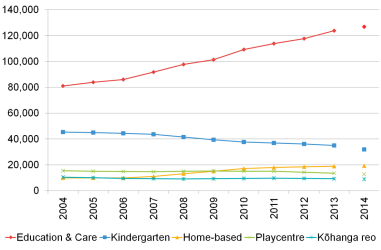
Preschool decisions are a bit fraught. I recall the decision making we used while trying to figure out where to send the kids: a private one, I thought, would require less from me in terms of selling things like chocolate bars, trike a thons and cake baking. A private one would also provide me with some respite from my three under 4 as sessions not dictated by school holidays!
We also recall the sigh of relief when our youngest started at school, ridding our monthly budget for the cost of the privately owned preschool of around $250 per month per child.
I have had a wee look at five relatively simple preschools: single non profit entities. I have used both their Charities office financial records, along with enrolment figures from ERO. It’s quite interesting.
Wages, predictably, make up between 77% and 88% of total costs. And it looks as if the ECE funding supplied by the tax payer pretty much covers wages. The next biggest cost can be rent: but again, it depends. Some own their land and buildings, a testimony to the work of previous generations. Of course, that then pushes more cost to insurance, especially in a post EQ Christchurch. Others get subsidised rent through a relationship with a local school. And still others pay commercial rents.
Parent contribution can range from 17% of total revenue, down to 4%. Obviously this ratio will depend on the parents’ ability to pay, but its interesting (I think!) that for those with a lower parent contribution have a higher cost per child (almost $16k per child in one case) to the preschool with a higher parental contribution having total costs of $9k per child.
So where is the extra money coming from? Grantmakers. There is an easy narrative around applying for funding “for the children”. Sand pit covers, Red Cross courses, shade sails and theubiquitous and never ending bucket of ICT.
So all very interesting, but to me, the bigger issue here is the relationship back to private enterprise. According to the Education census, last published for 2014 data, there were 4299 licensed services. This excludes playgroups, of which there are 857. Now, sadly, the census does not take ownership model into account. But what is interesting here is this chart, taken from the government’s education census. It shows the number of enrolments / attendances in licensed services by service type. Now, this chart does not identify what is privately owned, BUT it’s fairly easy to see where the growth is. And I would hazard a guess that many of these service providers in the education and care sector are privately owned. These privately owned businesses are “making it work” with available resources, available funding, and providing a return to the owners for doing so. IRD tells me that private enterprises of the size I have looked at will make a return on equity of (on average) 22%. The organisations I looked at? All except one made a loss last year.
Now, I know that choice is a marvellous thing, and I understand that people tend to be wedded to the decisions they have made for their kids. But I also know that sometimes it’s difficult for a not for profit to make some hard calls around the commercial realities of doing what they do, and that a wider strategic analysis can be hard. Going to grant makers for support is an easy option, but not necessarily the best. It would be interesting to look at small private businesses, larger ones, and some of the larger not for profits (such as kindergartens who present consolidated accounts).
And why is this important to grant makers: opportunity cost. A dollar is a dollar, and if you do want to front up to your stakeholder to justify your role in the community, or justify the tax free status you receive, then there is an obligation to ensure that each dollar of spend delivers maximum bang for your community.
Would love to talk with you if you think this is just a little bit interesting.
 RSS Feed
RSS Feed